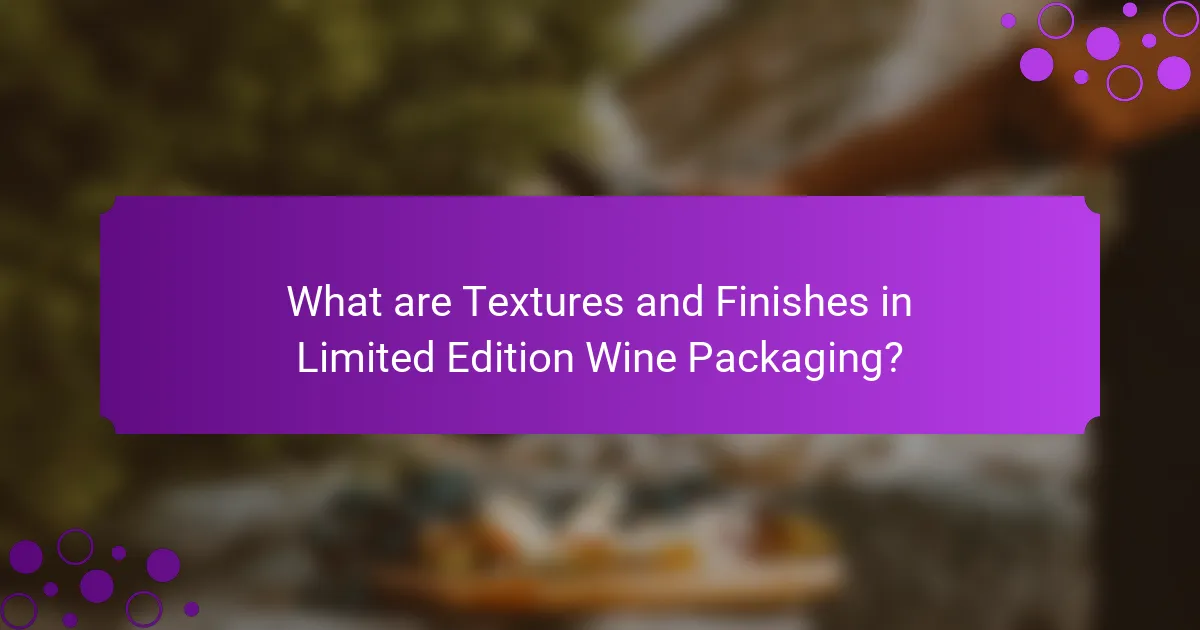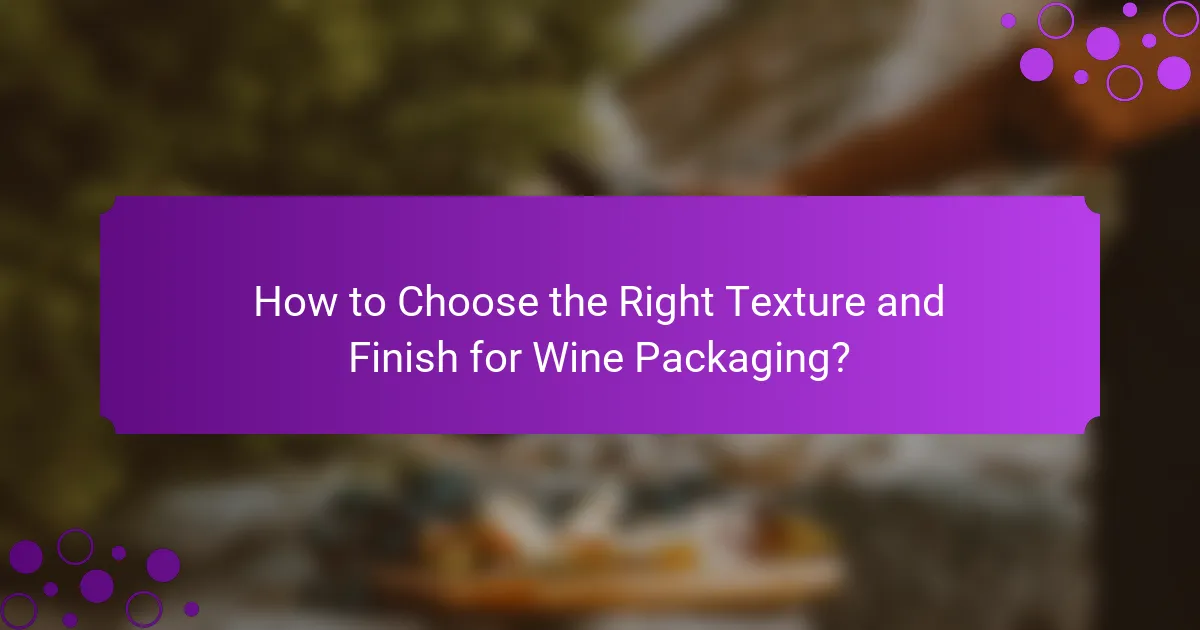
What are Textures and Finishes in Limited Edition Wine Packaging?
Textures and finishes in limited edition wine packaging refer to the tactile and visual elements that enhance the product’s appeal. Textures can include embossed patterns, soft-touch coatings, or matte finishes, creating a sensory experience. Finishes may involve glossy varnishes, metallic foils, or unique inks that catch the eye. These elements serve to differentiate the product in a competitive market. Limited edition packaging often utilizes these attributes to convey exclusivity and craftsmanship. Research indicates that premium packaging can increase perceived value by up to 30%. This highlights the importance of textures and finishes in attracting consumers and elevating brand identity.
How do textures and finishes enhance the appeal of wine packaging?
Textures and finishes significantly enhance the appeal of wine packaging by creating a tactile and visual experience. These elements attract consumers’ attention on retail shelves. For instance, a matte finish can convey elegance, while a glossy surface suggests modernity. Textures, such as embossing or debossing, add depth and interest. They can evoke sensory associations with the wine’s flavor profile. Research shows that packaging design influences purchasing decisions, with 70% of consumers admitting to choosing products based on appearance. Therefore, effective use of textures and finishes can increase perceived value and desirability.
What types of textures are commonly used in wine packaging?
Common textures used in wine packaging include embossed, matte, glossy, and textured paper finishes. Embossed textures create a raised design that adds a tactile element. Matte finishes provide a non-reflective surface, enhancing a sophisticated look. Glossy finishes offer a shiny appearance, making colors appear more vibrant. Textured paper finishes can simulate natural materials, adding a unique feel. These textures not only enhance aesthetic appeal but also influence consumer perception of quality. Studies show that packaging texture can significantly impact purchasing decisions in the wine market.
How do different finishes affect the visual and tactile experience?
Different finishes significantly impact both the visual and tactile experience of products. Visual effects include variations in gloss, matte, or textured surfaces. Glossy finishes reflect light, enhancing colors and creating a vibrant appearance. Matte finishes absorb light, offering a softer, muted look. Textured finishes add depth and dimension, inviting touch and engagement. Tactile experiences are influenced by the smoothness or roughness of the surface. Smooth finishes feel sleek and refined, while rough textures evoke a natural, organic feel. Research indicates that consumers often prefer tactile engagement, as it enhances perceived quality and value. A study by Hagtvedt and Brasel (2016) found that tactile elements can influence purchasing decisions in luxury goods. Thus, the choice of finish plays a crucial role in shaping consumer perception and experience.
Why is limited edition packaging important for wine brands?
Limited edition packaging is important for wine brands because it enhances perceived value and exclusivity. Unique designs attract consumers and create a sense of urgency to purchase. According to a study by the Wine Market Council, limited editions can boost sales by up to 30%. This packaging often incorporates premium materials and finishes, making the product stand out on shelves. Additionally, it allows brands to tell a story or celebrate an occasion, further engaging customers. The emotional connection fostered by such packaging can lead to brand loyalty and repeat purchases.
What role does packaging play in consumer perception of quality?
Packaging significantly influences consumer perception of quality. High-quality packaging materials and design can create a premium image. Research shows that consumers often associate attractive packaging with better product quality. For instance, a study by Silayoi and Speece (2007) found that packaging design affects consumer buying decisions. The visual appeal of packaging can enhance perceived value, leading to higher purchase intentions. Additionally, tactile elements, such as texture and finish, can further elevate the perception of quality. Consumers are more likely to trust products with well-designed packaging. This trust can translate into brand loyalty and repeat purchases.
How can limited edition packaging create a sense of exclusivity?
Limited edition packaging creates a sense of exclusivity by offering unique designs and features not found in standard products. This packaging often includes special materials, finishes, and textures that enhance the visual and tactile experience. Consumers perceive these elements as a mark of luxury and rarity. For instance, limited runs can feature embossed logos or metallic accents that elevate the product’s aesthetic. Additionally, the scarcity of limited edition items drives demand and increases perceived value. Research shows that consumers are willing to pay a premium for products that feel exclusive. This combination of unique design and scarcity fosters a strong emotional connection with the product.

What are the Trends in Textures and Finishes for Wine Packaging?
Current trends in textures and finishes for wine packaging emphasize tactile and visual appeal. Textured labels are increasingly popular, enhancing the sensory experience. Matte finishes are favored for their modern look and subtle elegance. Glossy finishes remain prevalent, offering vibrancy and eye-catching aesthetics. Embossing and debossing techniques are used to create depth and dimension. Sustainable materials are on the rise, reflecting eco-conscious consumer preferences. Metallic accents are utilized for luxury appeal, adding sophistication to the packaging. These trends indicate a shift towards creating a memorable unboxing experience for consumers.
What innovative materials are being used in wine packaging today?
Innovative materials used in wine packaging today include biodegradable plastics, glass alternatives, and lightweight aluminum. Biodegradable plastics are made from renewable resources and reduce environmental impact. Glass alternatives, such as Tetra Pak and bag-in-box systems, offer lighter options and enhance transport efficiency. Lightweight aluminum is increasingly popular for its recyclability and reduced carbon footprint. These materials are gaining traction due to consumer demand for sustainable packaging solutions. Additionally, some wineries are experimenting with plant-based inks and coatings to further minimize environmental effects.
How do sustainable practices influence packaging choices?
Sustainable practices significantly influence packaging choices by prioritizing environmentally friendly materials and processes. Companies are increasingly opting for biodegradable or recyclable packaging options. This shift reduces waste and minimizes environmental impact. For instance, using post-consumer recycled materials in packaging can lower carbon footprints. Additionally, brands are adopting minimalist designs to reduce material usage. Research shows that 62% of consumers prefer brands that use sustainable packaging. This consumer preference drives companies to innovate in their packaging strategies. Ultimately, sustainable practices lead to packaging that aligns with ecological values and consumer expectations.
What are the latest design trends in wine packaging textures?
Latest design trends in wine packaging textures include the use of tactile finishes and innovative materials. Textured surfaces, such as embossing and debossing, enhance the sensory experience. Sustainable materials are increasingly favored, reflecting eco-conscious consumer preferences. Matte and soft-touch finishes are popular for their modern appeal. Additionally, metallic accents are used to create visual contrast and luxury. These trends aim to engage consumers emotionally and differentiate brands in a competitive market. Recent studies indicate that unique textures can significantly influence purchasing decisions, highlighting their importance in packaging design.
How do cultural influences shape packaging design in the wine industry?
Cultural influences significantly shape packaging design in the wine industry. Different cultures have distinct aesthetic preferences and symbolism associated with wine. For instance, in France, elegance and tradition are emphasized, often using minimalist designs. In contrast, Italian wine packaging may feature vibrant colors and artistic elements reflecting the country’s rich heritage.
Cultural perceptions of wine also dictate material choices. For example, eco-friendly packaging is increasingly favored in cultures prioritizing sustainability. Additionally, cultural narratives can influence labeling, where storytelling elements resonate with local consumers. Research indicates that packaging appealing to cultural values can increase consumer engagement and brand loyalty.
In summary, cultural influences dictate aesthetic choices, material preferences, and narrative elements in wine packaging design.
What regional differences exist in wine packaging aesthetics?
Wine packaging aesthetics vary significantly by region. In France, elegance and tradition dominate, often featuring classic labels and minimalist designs. Italian wine packaging emphasizes vibrant colors and artistic labels, reflecting the country’s rich cultural heritage. In the United States, innovation is key, with bold graphics and modern materials attracting consumers. Australian wines often use eco-friendly packaging, highlighting sustainability alongside unique textures. Spanish wine packaging frequently incorporates traditional motifs and earthy tones, emphasizing authenticity. These regional differences are influenced by cultural values, market trends, and consumer preferences, shaping the visual identity of each wine brand.
How do consumer preferences vary across different markets?
Consumer preferences vary across different markets due to cultural, economic, and demographic factors. In the wine market, preferences can differ significantly based on regional tastes. For instance, consumers in France may prefer traditional packaging, while those in the U.S. might favor innovative designs. Economic factors also influence preferences; affluent markets often lean towards premium packaging. Demographics play a role as well; younger consumers may prioritize sustainability in packaging choices. Studies, such as those from the International Journal of Wine Business Research, show that consumer behavior is heavily influenced by local trends and values. These variations highlight the need for targeted marketing strategies in different regions.

How to Choose the Right Texture and Finish for Wine Packaging?
Choosing the right texture and finish for wine packaging enhances the product’s appeal. Texture influences tactile engagement and visual perception. A matte finish can convey elegance, while a glossy finish suggests luxury. Embossing adds a three-dimensional effect, making the packaging stand out. Consider the target audience when selecting textures. Research shows that consumers often associate premium wines with specific textures and finishes. For example, a study by the University of California found that packaging influences purchasing decisions significantly. Therefore, aligning texture and finish with brand identity is crucial for effective wine packaging.
What factors should be considered when selecting textures and finishes?
When selecting textures and finishes for limited edition wine packaging, several factors should be considered. The first factor is the tactile experience. Textures can enhance the sensory appeal of the packaging. A study by the Packaging Association found that tactile elements influence consumer perception significantly.
Another factor is visual impact. The finish can affect the overall aesthetic and branding of the product. Glossy finishes often convey luxury, while matte finishes suggest sophistication.
Durability is also crucial. The chosen texture and finish should withstand handling and environmental conditions. For instance, water-resistant finishes are essential for wine bottles exposed to moisture.
Sustainability is increasingly important. Eco-friendly materials and finishes can attract environmentally conscious consumers. Research indicates that 66% of consumers prefer sustainable packaging options.
Finally, cost-effectiveness must be evaluated. The selected textures and finishes should align with the budget while achieving the desired impact. Balancing these factors ensures effective and appealing wine packaging.
How do brand identity and target audience impact packaging choices?
Brand identity and target audience significantly influence packaging choices. A strong brand identity shapes how a product is perceived. It dictates design elements like color, typography, and imagery. These elements must resonate with the target audience’s preferences and values. For instance, luxury wine brands often use elegant, minimalist packaging to convey sophistication. Research shows that 64% of consumers make purchase decisions based on packaging alone. Thus, aligning packaging with brand identity and audience expectations enhances market appeal and drives sales.
What practical tips can help in the selection process?
Identify the target audience for the limited edition wine packaging. Understanding consumer preferences is crucial. Research current design trends in wine packaging. This can inform choices on textures and finishes. Evaluate the product’s brand identity. Ensure the selected materials align with the brand image. Consider the tactile experience of the packaging. Textures can enhance consumer engagement. Test various finishes for durability and aesthetic appeal. Conduct focus groups to gather feedback on packaging options. This provides insights into consumer perceptions. Use sustainable materials when possible. Eco-friendly packaging can attract environmentally conscious consumers.
What are the common challenges in designing wine packaging?
Common challenges in designing wine packaging include balancing aesthetics and functionality. Designers must create visually appealing packaging that attracts consumers while ensuring it protects the wine. Sustainability is another challenge, as eco-friendly materials can be more expensive and less available. Compliance with regulations regarding labeling and alcohol content adds complexity to the design process. Additionally, differentiating the product in a saturated market requires innovative designs that convey the brand’s identity. Finally, ensuring that packaging is practical for transportation and storage is crucial to prevent damage.
How can brands overcome issues related to cost and production?
Brands can overcome issues related to cost and production by optimizing their supply chain and leveraging technology. Streamlining the supply chain reduces unnecessary expenses. Implementing just-in-time production minimizes inventory costs. Utilizing automation in manufacturing increases efficiency and lowers labor costs. Brands can also negotiate better rates with suppliers for materials. Investing in sustainable materials may lead to long-term savings. Research shows that companies adopting these strategies can reduce production costs by up to 30%. This data supports the effectiveness of these approaches in overcoming cost-related challenges.
What best practices should be followed for effective wine packaging design?
Effective wine packaging design should prioritize visual appeal, brand identity, and functionality. Visual elements must attract consumers and convey the wine’s quality. Brand identity should be consistent across all packaging to enhance recognition. Materials used must protect the wine and maintain its integrity. Sustainability is increasingly important, so eco-friendly materials are recommended. Clear labeling of wine type, origin, and alcohol content is essential for transparency. Unique textures and finishes can create a tactile experience, enhancing consumer engagement. Research shows that well-designed packaging can increase purchase intent by up to 70%.
What are the key takeaways for creating impactful limited edition wine packaging?
Key takeaways for creating impactful limited edition wine packaging include unique design, quality materials, and storytelling elements. Unique design captures attention and differentiates the product. Quality materials enhance the tactile experience and suggest premium value. Storytelling elements connect emotionally with consumers, creating a memorable experience. Research indicates that visually appealing packaging can increase purchase intent by up to 70%. Additionally, incorporating textures and finishes can make the packaging more engaging and luxurious.
The main entity of this article is limited edition wine packaging, specifically focusing on the textures and finishes that enhance its appeal. The article explores how various tactile and visual elements, such as embossed patterns, matte finishes, and unique inks, contribute to consumer perception and purchasing decisions. It highlights the significance of these attributes in conveying exclusivity and craftsmanship, as well as current trends towards sustainable materials and innovative designs. Additionally, the article discusses the impact of cultural influences and regional differences on packaging aesthetics, providing practical considerations for brands in selecting effective textures and finishes.